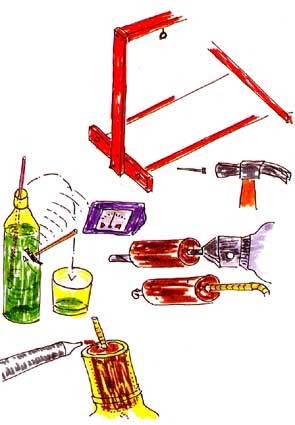|
|
 |
VIDROFONE
ONCE UPON A TIME...
The first time that 1 saw and heard someone play an instrument like this one was at a circus, when 1 was still in short trousers, and the wooden board I was sitting on must have been orthopedic, because it was so very hard against my poor little backside. The instrument had a large chrome-plated iron stand and, 1 think, a chromatic range of two octaves, or, in other words, 24 notes. A chromatic scale has 12 notes, the seven natural ones from DO to SI and the accidentals, commonly referred to as sharps or flats, which are 5 in number (the black keys of the piano, in an octave). You canít begin to believe how confused 1 was by the fact that apparently identical bottles could make such different sounds. Whatís more, they were all brightly coloured and reflected the circus lights, giving everything a magical appearance. And so, there 1 was thinking to myself ... magic ... thatís what it must be, this is a magicianís trick. But it wasnít, and later on 1 discovered the secret that Iím going to share with you now.
MATERIAL NEEDED
Some wooden bars for the stand, 5 glass bottles, some string, 5 new corks, 5 screw-in hooks and a toy hammer.
TOOLS AND ACCESSORIES
A pair of scissors, a punch, a penknife, a drill with 3 mm bit, a hammer and some contact adhesive.
HOW TO MAKE THE INSTRUMENT
The bottles of this Vidrofone may or may not be supported on a stand. If you want, you can imagine a Wooden stand, based on the picture shown here. To make this, youíll have to drill holes in the corks with the 3 mm bit (be very careful if youíre using an electric drill, because corks tend to crumble very easily). If you can, use a hand drill (itís less dangerous and doesnít cause the cork to crumble so much). This hole is made for the string to pass through, so that you can hang the bottle, after youíve put the cork in its neck, of course. Now weíre going to reveal the great trick of how you tune the bottles. Put some tap water in each of them. Using a plastic toy hammer or even just a stick, hit one of them and try to listen to the note that you get from it. In order to do this, you need to have a correctly tuned instrument that will serve as a reference for comparisons. If you have an electronic tuner, the tuning will be much more accurate. Another idea is to ask your music teacher or a friend whoís got a well-trained musical ear for help. Then, using a straw, extract water from each bottle until you get the notes that you want. And this is where the real trick is. The less water you use, the higher the note. If you want to colour the water, use anilines. After youíve tuned each of the bottles, youíll have to put the corks in, so that the liquid doesnít come out. If you lose any liquid from a bottle, this will mean that it goes out of tune. If you use corks that youíve threaded a string through, after youíve put them in the bottles, put a little contact adhesive over the cork, which will act as a seal, so that the liquid doesnít come out.
DECORATION
Donít place stickers on the bottles. Theyíll take some of the shine away from your musical notes. However, if you build a wooden stand, you can really let your imagination go. A much larger version of this instrument was played by clowns at circuses. This is your way of paying homage to these men, whose job it is to make people laugh. And what about the clowns themselves? Do you think that they always feel like laughing? People love going to the circus at Christmas time. But does that mean that the clowns donít eat for the rest of the year?
HOW TO PLAY THE INSTRUMENT
This instrument is not recommended for nervous people, for otherwise, instead of musical notes, all we would hear is the sound of glass shattering. As there are only 5 notes, you wonít be able to play very complicated tunes on this instrument. But, if you want, you can increase the number of bottles and, obviously, the number of musical notes.
